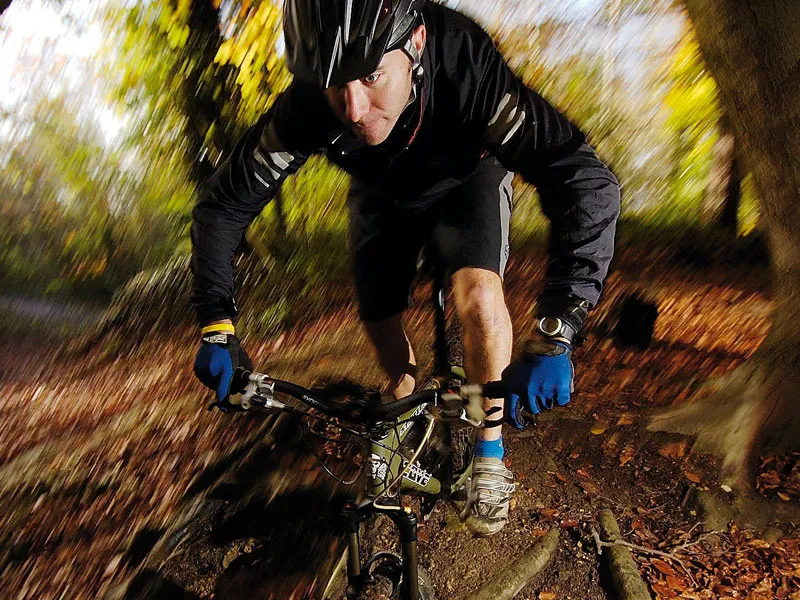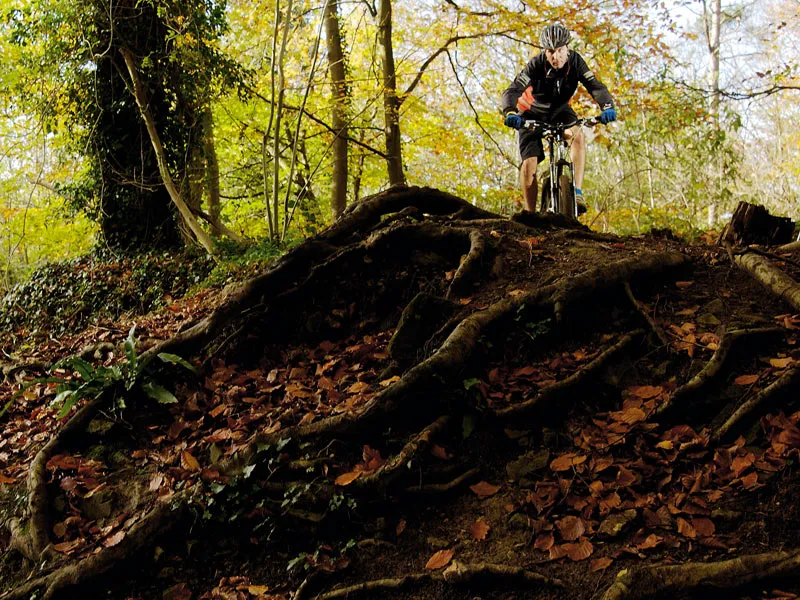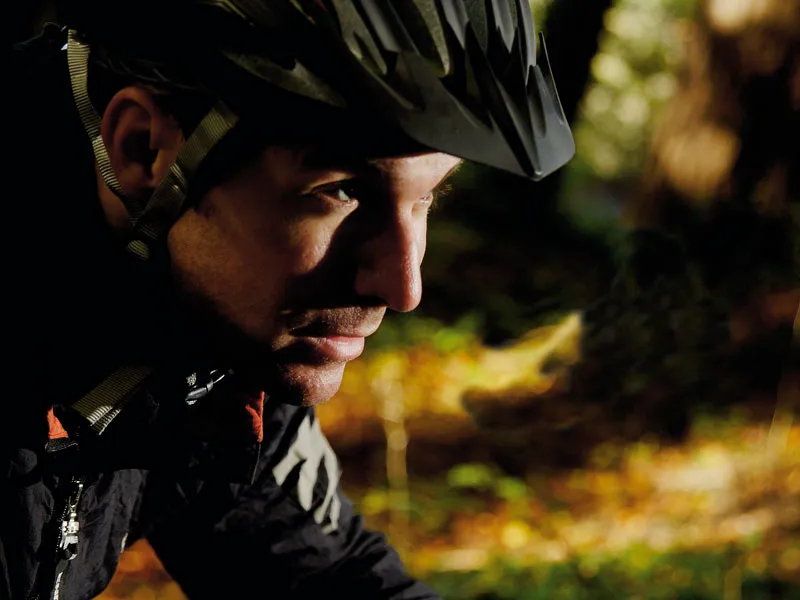Stop and think for a minute about all the times over the last year when you’ve let something get in the way of your mountain biking. It might have been bad weather, poor fitness, injury, work commitments, horrible hangovers or just ambivalence that kept you off the bike (or made you stop once you were out there). But each time we bet part of you still really wanted to ride. That part was the mountain biker inside you, the ‘you’ that would rather be on the bike than just about anywhere, the ‘you’ that reads MTB mags, watches downhill videos, and daydreams about sweet trails.
But the other, non-mountain biking ‘you’ stops you riding each time. It’s like having an angel and a demon on each shoulder, one says ‘ride’, the other ‘don’t ride’. Unfortunately, for most of us it’s nearly always easier to listen to the don’t ride voice. That’s why in this article we’re going to look at how you can get mentally tough enough to get on the bike, and stay on it, every time, even when you think that you don’t want to.
Barriers and limitations
We’ll start with the factors that can reduce your ability to ride. We’ll define barriers as events that stop you from riding, and limitations as the things that stop you from pushing your limits, or even finding out what your limits are.
Barriers to getting on your bike
Environmental: This is what we blame most often for stopping us riding. Bad weather (rain, cold), poor trail conditions (mud, slippery rocks and roots, more mud), difficult trails (steep hills, hard descents), and mechanicals have stopped all of us from time to time. The point is we live in a country that’s not exactly known for its dusty, sunny trails. If you want to mountain bike in Britain, you’re going to have to accept that poor conditions, sloppy trails, and resultant bike problems are largely outside your control. That leaves a simple choice: go riding if you’re already motivated, stay home if you’re not, or learn how to motivate yourself to ride even when the weather sucks.

Mental: Luckily, some of the barriers to riding are inside our sphere of influence, and therefore easier to change. Mental barriers are mostly formed by our negative thoughts or emotions – including boredom, lethargy, stress, and previous incidents – yet are eminently controllable. The first trick to getting over a mental barrier to riding is simply identifying that it’s there. Boredom and lethargy are often pretty good signs. If you’re feeling bored and unmotivated to ride, something’s obviously wrong, so the next step is to figure out what it is. Are you doing the same trail over and over again, always riding with the same people? If so, try getting out with new bikers, like group rides with local shops or clubs, on new trails. Try riding with people at a higher skill level to you, so that you’re forced to learn some new tricks, or at least to push a little harder to keep up.
If you often find you’re tired, frustrated, and don’t think you have time to go mountain biking, chances are you’re stressed, and it’s important that you do something about it so that it doesn’t become a problem that can end up affecting your health. Talk to your boss about flexi-time or other ways to vary your working week, figure out how to balance your work and life better, try to get more sleep and eat a little healthier, and try yoga or mediation, or just some deep breathing.
‘Previous incidents’ are a little trickier. You first need to realise that they’re not actually failures. Crashing, injury, dropping out of a ride, or balking on a descent are all natural parts of becoming a better rider, and are important for learning how to improve for the next time. Learn from what went wrong, and figure out how to improve from the experience, so that every potentially negative riding experience becomes a lesson in how to become a better mountain biker.
Lastly, work on the techniques outlined below to make sure you’re properly focussed on what you’re doing when you’re on the trail.
Physical: Physical barriers, like mental ones, are under your control. The most common physical barriers are lack of fitness or riding skills, injury and illness. We’ve already looked at how to get over fitness and skill issues. When it comes to injury and illness, it’s all about prevention and recovery. Preventing illness and injury should be high on your agenda, yet many of the illnesses that keep us off the bike are lifestyle related. If you’re stressed, unfit, don’t get enough sleep, drink too much, smoke, and don’t eat properly, your immune system is going to be compromised, and you’re much more likely to come down with something. Have a look at how you’re living – then make some changes accordingly to help you and your body out. Avoid injury by warming up properly, training correctly, and giving yourself adequate rest periods in-between training. To recover better, you need to give your body a chance to fix itself, so enough sleep, good diet, less beer, no smoking, and some relaxation exercises will do wonders for your health.
Limitations while you’re riding
Mental: Let’s talk about fear. Fear’s a very powerful emotion, and it gets in the way of all sorts of situations. It’s a completely legitimate reaction too, and exists for good reasons. Fear is the end result of a series of hormonal and cognitive actions that evolved in order to keep us out of harm’s way. Unfortunately, in the modern world, it also often stops us doing things we want to do – like riding a super rocky or rooty descent. Fear is best understood as a psychological reaction to the ‘fight or flight instinct, a system that evolved in our deep ancestral past to keep us alive by fighting whatever threatened us, or running away from it as fast as possible.

Basically, it works like this: something happens in your environment, and your body reacts very quickly by releasing adrenaline from the adrenal glands near the top of your kidneys. Adrenaline works very fast, kicking off a cascading set of actions. Your heart rate and breathing quicken in order to get energy and oxygen to your muscles, blood is diverted to your major muscles but away from the skin (so that you can run fast but won’t bleed heavily if you become wounded or cut), your bowels and urinary system temporarily shut down (and sometimes void themselves), your vision narrows (so you won’t be distracted by peripheral events), and your cerebral cortex (the bit of your brain you do most of your thinking with) reduces its functions so you don’t think about anything except survival. You can also feel nauseous, spaced out and, obviously, all this together equals the feeling of being bloody afraid.
When it comes to mountain biking, however, fear is not good. It degrades your ability to think, damages reflexes, makes you stiff and unresponsive, and multiplies the chances of crashing. It also makes you irrational as your brain shuts down functions, which means it can be hard to control. Unfortunately, because we’re quite complex mammals, fear pops up at the most inappropriate times. You might be gunning down a trail, wipe out, and scare yourself so much you’re unable to keep going. Or you might remember a past fall and suddenly find yourself shying away from trail trouble you normally ride easily. It also means that you’re less likely to try new stuff, or to push your limits. Like we said, fear is irrational, so it really doesn’t matter how hard core you are, even the top riders can be afraid, so it’s nothing to be ashamed of. Fear can also be controlled and conquered with the right attitude and mental toughness – we’ll explain how to combat your animal instincts over the page.
Physical: The biggest physical limitations to your riding are strength, endurance, and technical skills. Fortunately these are not insurmountable problems. Getting fitter and stronger is really just a matter of application, and as for trail riding skills, well, just get out and ride, and ride, and ride some more. That’ll help with all your fitness woes too! Physical limitations are often much easier to get over than mental ones, because they are more easy to deal with. Of course, you need to get out there to do it, which is where the mental side of mountain biking comes in again.
Mind over matter
If you’ve been mulling over what’s stopped you riding in the past, it’s more than likely been down to mind over matter. Even when you think your limits and barriers are physical or environmental, what it really comes down to is a mental effort to make yourself do something you don’t want to do, or don’t believe that you can do.

So now let’s learn some sports psychology techniques for getting you on the bike, up that hill, or down that drop off, even when you’re tired, cold, hurting, scared, or just can’t be arsed…
Tough enough?
Mental toughness, as the name implies, represents a state of mind that enables you to do things even when a big part of you doesn’t want to. It doesn’t really matter how fit or strong you are physically, if you haven’t got your head together you’re not going anywhere – and let’s face it, mountain biking is a head sport. Being mentally tough incorporates a series of techniques that help you to get going and keep going. But just like your regular physical and skills training, mental toughness takes time to develop, and needs constant work to improve and maintain. Think of them as a part of your regular training, make them a part of that training, and you’ll be set.
If you stick at these techniques for the next three months, you’ll be amazed at the results: you’ll ride harder, better, and for longer, and you’ll find it easier and easier to get on the bike, even in the middle of a bleak British winter…
Disassociation dilemmas
‘Disassociation’ is the technical word for taking your mind off something unpleasant. There are two types we need to know about: passive and active. Passive disassociation is what most of us do up a steep climb or when we’re hurting, we daydream. It gets you out of your head for a while, but when you stop concentrating when riding, you start falling off, so it’s not the best way.
A better technique is active disassociation. You can do this by focusing fully on what you’re doing at a given moment. Start by thinking about your body position, cadence, and breathing. Are you relaxed on the bike? Are you focussed on the trail ahead, ready for the next obstacle? Are you in the right gear? Effectively, active disassociation is about concentrating fully on the here and now, so that there’s no time to think about the pain or discomfort. It puts you fully in control of what you’re doing and stops you from being distracted.

Try practicing active disassociation and you’ll be amazed at how it brings you into the moment and helps you concentrate on what you need to do. Remember to try and catch yourself when you’re daydreaming and bring yourself back into the present. This is an exercise that requires regular practice to maintain and improve; if you don’t you could lose the skills you’ve gained.
Temporal focus
This is another method of bringing you back into the present. It’s also a great way to take your mind off the pain or to make sure you nail every corner and drop. There are two different psychological techniques to learn here: moment-to-moment, and chunking.
Moment-to-moment is about forcing yourself to think only about what is happening right now. It’s a little different from active disassociation, because it involves convincing yourself that what you’re doing in the current moment (that drop off, this corner, that root) is the only thing you’re going to do for your whole ride. You put 100 per cent of your concentration and ability into that one action, without letting yourself think about anything that’s happened beforehand or that’s going to happen. Once you’ve finished that one action, you go through the same process again for the next bit, and the next, and so on, until you get to the end.
But the last thing you want on a tricky section of climbing or descending is to be thinking about or imagining previous failures, or daydreaming about the pub after the ride. Moment-to-moment forces you to be right here, right now, with all of your ability.
Meaty chunks
Chunking is for longer endurance sections, like getting to the top of a long hill or making it through a race. In this case you break the ride down into more manageable ‘chunks’,
and convince yourself that each of these chunks is the only bit you’re going to have to ride. Chunking can be in units of time (‘just five more minutes’), distance (‘just to the top of this hill’) or combined with effort (‘just to the next tree at this pace’). Once you complete your chunk, you set up another one. Don’t let yourself think about past or future chunks, just one, then another, then another, until the ride is finished. Combine this practice with active disassociation to keep your mind off the pain, and stay focussed on your technique.
Again, try to practice these skills every time you’re on the trail. Remember, moment-to-moment for situations where you need to be really on it, like freeriding and downhill, and chunking for endurance riding.
Mr Motivator
It sounds stupid, but motivation is mostly about fooling yourself into thinking you want to do something until you actually want to do it. To motivate yourself to do something that doesn’t seem so cool (like riding when it’s 3°C and raining ) you’ll need to give yourself lots of reasons why. These can be both external and internal – what’s called extrinsic and intrinsic motivation. Extrinsic are factors outside of you that can motivate action, like peer pressure, riding to lose weight, or riding to win competitions. Intrinsic is doing something for its own reward, like riding because it makes you feel good or gives you a sense of accomplishment. Usually, we start something because of extrinsic motivators but, over time, we continue it for intrinsic reasons. For example, you might’ve started riding because your mates were into it, but you ride now for the sheer pleasure of it.
Nevertheless, you need quite a lot of intrinsic motivation to get you out riding when it’s blowing a gale, or to keep going when you’re in pain, so it doesn’t hurt to keep some external motivators around. Perhaps the latest freeride DVD, or the latest BikeRadar feature article, and especially a group of riding buddies who are the ones that are out in all weather! Anything that can consistently encourage you to get your gear on, out the door, and out on the trail. Once you’re out there it gets easier – think of the number of times you’ve forced yourself out the door, but come back with a big grin on your face. Just do it.
